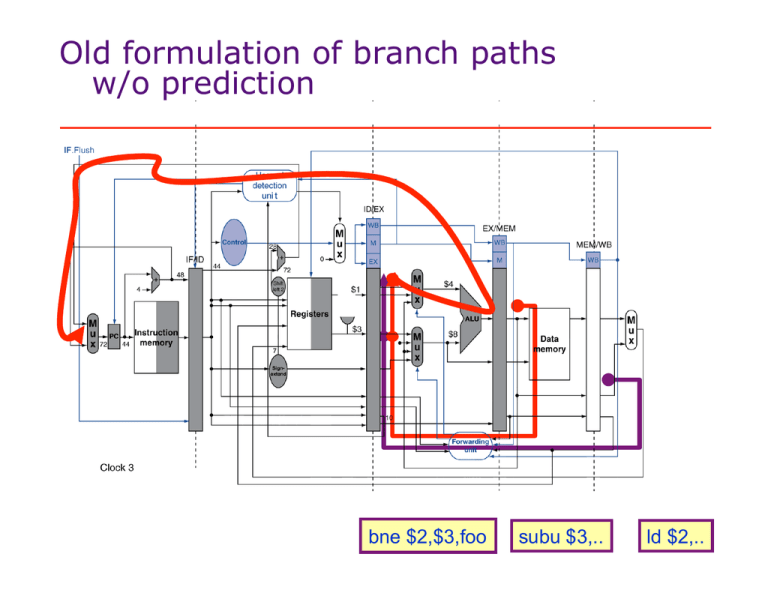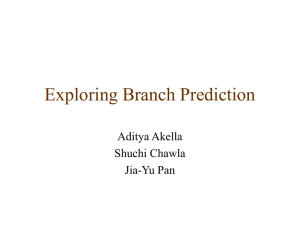Old formulation of branch paths w/o prediction
advertisement

Old formulation of branch paths w/o prediction bne $2,$3,foo subu $3,.. ld $2,.. Cleaner formulation of Branching Back End Front End Instr Cache dcache Instr FIFO branch resolution login dequeue “Guess” PC PC FIFO != “restart at address X” Invariant: is_correct(PC) is_correct(Instr[PC]) arch. PC misprediction penalty On restart (branch misprediction) must – a. kill all incorrectly fetched instructions (to ensure correct execution) b. refill pipeline (takes # cycles == latency of pipeline up to execute stage) Aside: Decoupled Execution Buffering Smooths Execution and Improves Cycle time by Reducing Stall Propagation Front End F6 S1 C7 F6 FIFO Back End (f=fetch, s=stall, c=cache miss, e=execute) E2 C8 E8 Cycle FE FIFO BE F F F F F F S C C C C C C C F F F F F F 1 1 1 2 3 4 4 4 4 4 4 3 2 1 1 1 1 1 1 E E C C C C C C C C E E E E E E E E The front end runs ahead .. stalls + cache misses are overlapped. FE F F F S S S S S S S S F F F S C C C C C BE E E C C C C C C C C E E E S S S S S S without decoupling .. stalls + cache misses are not overlapped. Pipelined Front End Back End bne+ $2,$3,foo branch direction predictor Instruction Cache Instr FIFO br. imm EA checker +4 GPC pc PC FIFO restart new pc Branch Predicted-Taken Penalty br br dir predictor Instruction Cache +4 GPC X Back End X Instr FIFO br. imm EA checker pc PC FIFO Speculatively Squash Fetch Instructions restart That Follow Branch new pc Branch Misprediction Penalty Back End Front End Instr Cache X X X“Guess” X PC X X XXX X X Instr X FIFO dequeue PC FIFO “restart at address X” != X XX dcache branch Xresolution Xlogin X Xarch. X PC Pentium 3 – ~10 cycles Pentium 4 – ~20 cycles “The Microarchitecture of the Pentium 4”, Intel Technology Journal Q1 2001 Since misprediction penalty is larger, we first focus on branch (direction) prediction • Static Strategies: - #1 predict taken (34% mispredict rate) - #2 predict (backwards taken, forwards not) (10%, 50%) mispredict rate - same backwards behavior as #1 - better forwards behavior (50%-50% branches) penalty: #1 taken 2 cycle ~taken 20 cycle #2 taken 20 cycle ~taken 0 cycle #1 forward branch ave execution time = 50% * 2 + 50% * 20 = 11 cycles #2 forward branch ave execution time = 50% * 20 + 50% * 0 = 10 cycles backward 90% forward 50% JZ JZ Since misprediction penalty is larger, we first focus on branch (direction) prediction • Static Strategies: #3 profile (see next slide for misprediction %’s) - choose a single prediction for each branch and encode in instruction - some studies show that sample runs are fairly representative of inputs in general - negative: extra programmer burden See next slide for misprediction rates Profiling Based Static Prediction Each branch is permanently assigned a probable direction. To do better we would need to change the prediction as the program runs! 15% ave. (specint92), 9% ave. (specfp92) misp rate A note on prediction/misprediction rates Qualitatively, ratio of misprediction rates is better indicator of predictor improvement. 15% ave. (specint92), 9% ave. (specfp92) misp rate (assumes misprediction probability independent between branches) Prediction Rate (p) Misprediction Rate # Consecutive Branches Predicted Correctly (w/ 50% prob) Bernoulli Process: pk = .5 50% 50% 1 78% 22% 2.78 85% 15% 4.26 91% 9% 7.34 95% 5% 13.5 96% 4% 16.98 98% 2% 34.3 k = lg(.5)/lg(p) 2% makes a huge difference here Compiler also can take advantage of Static Prediction / Profiling / Knowledge • Static Strategies: - #1 predict taken (34% mispredict rate) - #2 predict backwards taken, forwards not (10%, 50% mispredict rate) - #3 profile (see previous slide) - #4 delayed branches always execute instructions after branches avoids need to flush pipeline after branch eliminates branch taken penalty and branch direction prediction penalty for loops where branch direction is determined early enough Observation: Static Prediction is limited because it only uses instructions as input + has a fixed prediction branch direction predictor Instruction Cache Instr FIFO br. imm EA +4 GPC pc PC FIFO restart new pc Dynamic Prediction: More inputs allow it to adjust the brand direction prediction over time branch (direction) predictor branch info mispredict instr pc feedback Instruction Cache Instr FIFO EA +4 GPC pc PC FIFO restart new pc branch info Dynamic Prediction: More detailed br. descr FIFO branch (direction) predictor branch-info mispredict instr pc feedback Instruction Cache Instr FIFO EA +4 GPC pc PC FIFO restart new pc branch-info Dynamic Branch Prediction – Track Changing Per-Branch Behavior • Store 1 bit per branch – the last outcome. • Use that to predict! taken 1 ¬ taken ¬ taken taken 0 Predict Taken Predict Not Taken 1-bit Predictor Loop Behavior wishy washy on loops top: add add beq top Prediction Outcome T T T T T T T T N T N T T T T T T T N T N T (No data – either use what is left over from before or initialize on i. fill with “predict taken” for backwards branches) Single Bit Predictor Analysis T T T T T T T N Two Bit Dynamic Predictor add some hysteresis • Store 2 bits per branch • Change the prediction after two consecutive mistakes! taken 11 ¬ taken taken Predict Taken 10 taken ¬ taken 01 taken ¬ taken ¬ taken Predict Not Taken 00 Two bit dynamic predictors • Better behavior on loops One misprediction per loop execution with two-bit prediction top: add add beq top Prediction Outcome T T T T T T T T T T N T T T T T T T T T N T Two Bit Predictor Analysis T T T T T T T N n-bit implementation blindly write into this hash table; branches may alias but that’s “ok” Branch (direction) Predictor compute state transition “Guess” PC read hash (many cycles later) branch info (pc/descr/outcome) write 4k n-bit counters n-bits branch descr prediction Branch History Table (BHT) ICache is c. branch? Accuracy of simple dynamic branch predictor: 4096-entry 2-bit predictor on Spec89 somewhat old benchmarks – probably need slightly larger predictors to do this well on current benchmarks 11% 18% 22% 12% vs profiling Limits of 2-bit prediction - ∞ table does not help much on spec89 - reportedly, more bits does not help significantly either. Exploiting Spatial Correlation Yeh and Patt, 1992 if (x[i] < y += if (x[i] < c -= 7) then 1; 5) then 4; If first condition false, second condition also false History bit: H records the direction of the last branch executed by the processor Two sets of BHT bits (BHT0 & BHT1) per branch instruction H = 0 (not taken) H = 1 (taken) ⇒ ⇒ consult BHT0 consult BHT1 Adapted from Arvind and Asanovic’s MIT course 6.823, Lecture 6 Accuracy with 2 bits of global history Less storage than 4k x 2bit but better accuracy (for these benchmarks) Yale/Peh in action: PPro Pentium Pro (1995) uses the result from the last two branches to select one of the four sets of BHT bits (~95% correct) 00 Fetch PC k 2-bit global branch history shift register Shift in Taken/ ¬Taken results of recent branch history Adapted from Arvind and Asanovic’s MIT course 6.823 Taken/¬Taken? Benefit of longer histories for fixediteration loops with small iteration counts • Unary encoding of branch patterns No mispredictions per (5-iter) loop execution with >= 5-bits of history top: add add beq top Prediction Outcome T T T T T T T N T T N T T T T T T N T T N T T T T T T N T N History Table / Prediction 0 1 1 1 1 -> N 1 1 1 1 0 -> T 1 1 1 0 1 -> T Doesn’t work for many-iteration loops – but relative error is 1 1 0 1 1 -> T smaller! Issue: exponential space (see next slide) 1 0 1 1 1 -> T Alpha 21264 Tournament Predictor “Predictor-Predictor”: 4K 2-bit counters indexed by branch address - chooses between two predictors: A. global predictor: 4K 2-bit counters indexed by 12-bit global history -> good for memorizing those constant loop constants -> we don’t store it for each branch, but across all branches. B. local predictor: track last 10 choices of a single branch 1024 10-bit entries containing history for that entry This history indexes into 1K 3-bit saturating counters History “Guess” PC 4k 2-bit counters global history predictor local history predictor 1k 1k 3-bit 10-bit entries counters 4k 2-bit counters predictor-predictor ICache prediction is c. branch? Tournament, Correlating, Local Predictor Performance Consecutively Correctly Predicted Branches w/ 50% probability: 2-bit ~10 correlating ~18 tournament ~25 Spec89 (size presumably in Kbit) Predicted-Taken Penalty br br dir predictor Instruction Cache +4 PC X Back End X Instr FIFO br. imm EA checker pc PC FIFO restart new pc Top N List of Ways to Avoid Branch-Taken Penalties 1. Unroll thy loops top: ld add beq top compiler Unrolling loops reduces the number of backwards-taken branches in the program, and thus many of the predicted taken branches. top: ld add bne out ld add beq top out: Matters most when loop bodies are small. Positive/Negatives? red arcs = common case in this example Top N List of Ways to Avoid Branch-Taken Penalties Positive/Negatives? 2. Unroll+ Reorder code into common paths and off-paths. top: ld add beq skip or compiler skip: beq top - Often need profiling to get this kind of information. -+ Avoid branch-taken penalties with the same accuracy limits as static branch prediction. - Often more instructions added to off-paths top: patch: ld add bne anti-skip bne out ld add bne anti-skip beq top jmp out anti-skip: or j patch out: Top N List of Ways to Avoid Branch-Taken Penalties 3. Delayed Branches top: a b c d bne b, top e compiler top: a b bne b, top c d e - Requires extra work that is independent of the branch that can be scheduled often not available. - Architecturally fixed number of delay slots. - Messy semantics – branches within branch delay slots? Exceptions? Positive/Negatives? Positive/Negatives? Top N List of Ways to Avoid Branch-Taken Penalties 4. Anulled Branches top: a b c d bne b, top e a b compiler top: killed if branch not taken! c d bne b, top a b e + Filler instruction are automatically independent of branch because they come from the next interation of the loop. It is easier to fill these than standard delayed branches. - Architecturally fixed number of delay slots. - Messy semantics – branches within branch delay slots? Exceptions? Top N List of Ways to Avoid Branch-Taken Penalties Positive/Negatives? 5. Fetch Ahead (So as Not to Fall Behind) Front End Instr FIFO Back End 2 1 + Fetch unit can fetch more instructions per cycle than the backend can consume, filling the FIFO more quickly. Then, the front end can afford to spend a few cycles on each taken branch. Top N List of Ways to Avoid Branch-Taken Penalties 6. Branch Target Buffer Branch Target Buffer Positive/Negatives? branch (direction) predictor branch info mispredict instr pc fix BTB guess? feedback Instruction Cache Instr FIFO +4 EA BTB GPC pc PC FIFO “btb override” restart new pc branch info BTB Design override Positive/Negatives? to i-cache




